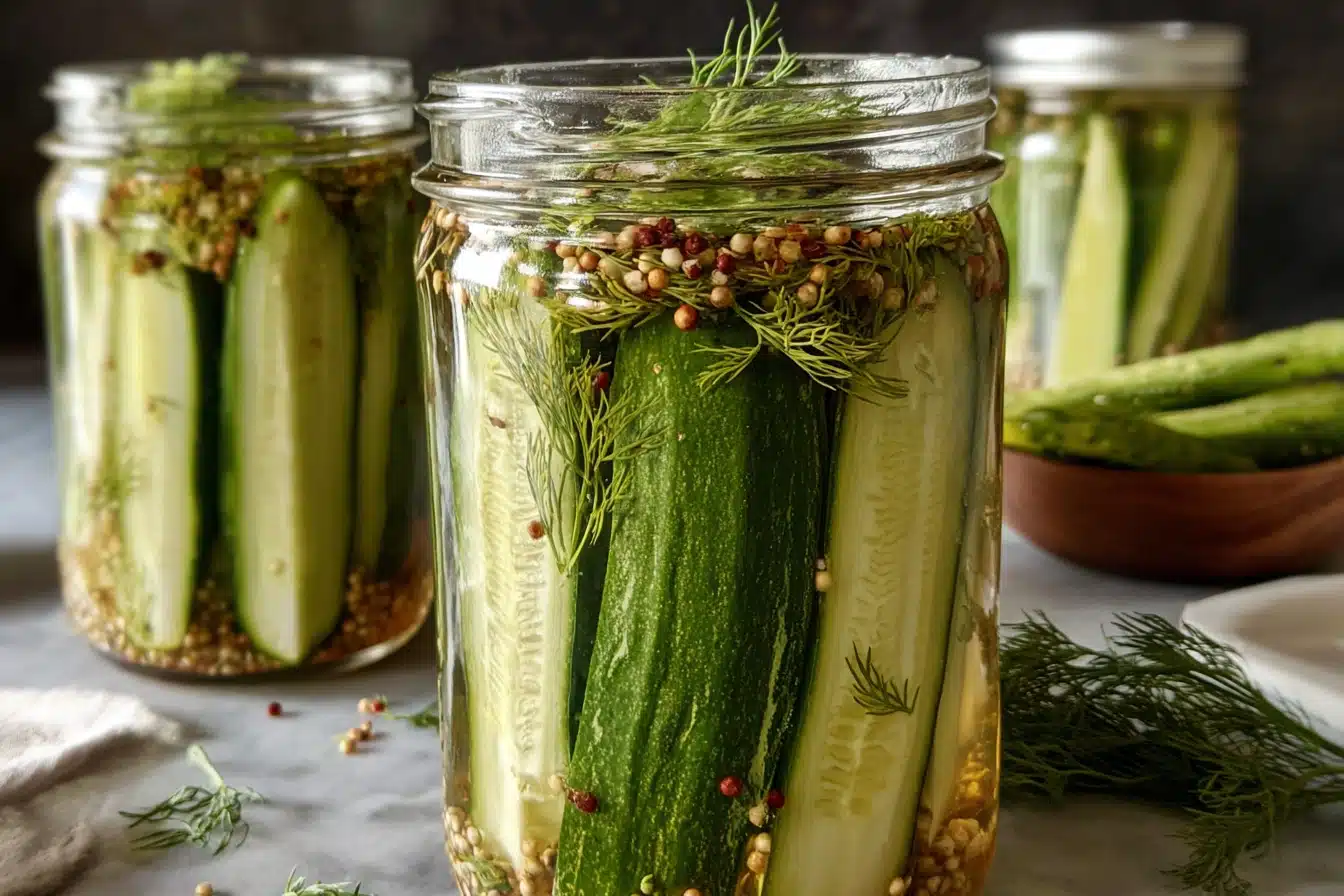Table of Contents
Sometimes you just want pickles—fast. Not a week from now. Not after boiling jars and busting out a pressure canner. Right now. That’s where these quick & easy refrigerator dill pickles come in. They’re crisp, loaded with garlic and dill, and they skip the drama of traditional canning. Perfect for when your garden’s exploding or you grabbed too many cucumbers at the farmer’s market.
I discovered the joy of refrigerator pickles after a long, hot afternoon with way too many cukes and not enough patience. I didn’t want soft, store-bought excuses. I wanted bright, tangy spears that snapped when you bit into them. So I threw together a brine, packed some jars, and waited overnight. The next day? Pickle bliss.
These pickles won’t last a year in your pantry—but they’re not supposed to. They’re made to be eaten. To liven up sandwiches. To vanish at barbecues. To turn late-night snacking into something special. And the best part? You probably already have everything you need in your kitchen.
If you’ve never made pickles before, this recipe is your gateway drug. If you have, it’s the lazy-day version you’ll keep coming back to. Let’s make some fridge magic.
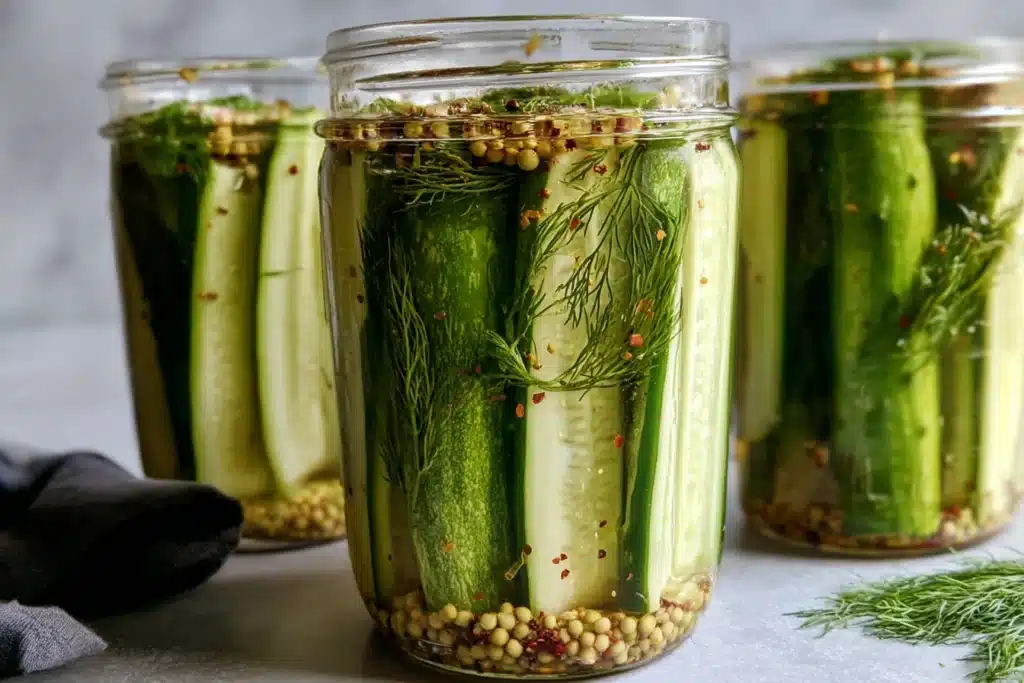
Why You’ll Love This Recipe
- No canning equipment required
- Crisp, garlicky flavor in just 24 hours
- Uses basic pantry ingredients
- Perfect for small batches
- Keeps well in the fridge for weeks
- Easy enough for beginners
Ingredients
- 1 lb pickling cucumbers (about 4–6 small)
- 1 cup water
- 1 cup white vinegar (5% acidity)
- 1 tablespoon kosher salt
- 1 teaspoon sugar
- 3 cloves garlic, smashed
- 4 sprigs fresh dill (or 1 tsp dried dill seeds)
- 1/2 teaspoon black peppercorns
- 1/4 teaspoon red pepper flakes (optional)
Instructions/Method
- Prep the Cucumbers: Wash and slice cucumbers into spears or rounds. Set aside.
- Make the Brine: In a saucepan, combine water, vinegar, salt, and sugar. Heat just until salt and sugar dissolve. Let cool.
- Pack the Jar: In a clean mason jar, layer in garlic, dill, peppercorns, and red pepper flakes. Add cucumber slices.
- Pour the Brine: Pour cooled brine over cucumbers until fully submerged. Leave 1/2 inch of headspace.
- Seal and Store: Screw on lid and refrigerate. Let sit 24 hours before eating. Best after 2–3 days.
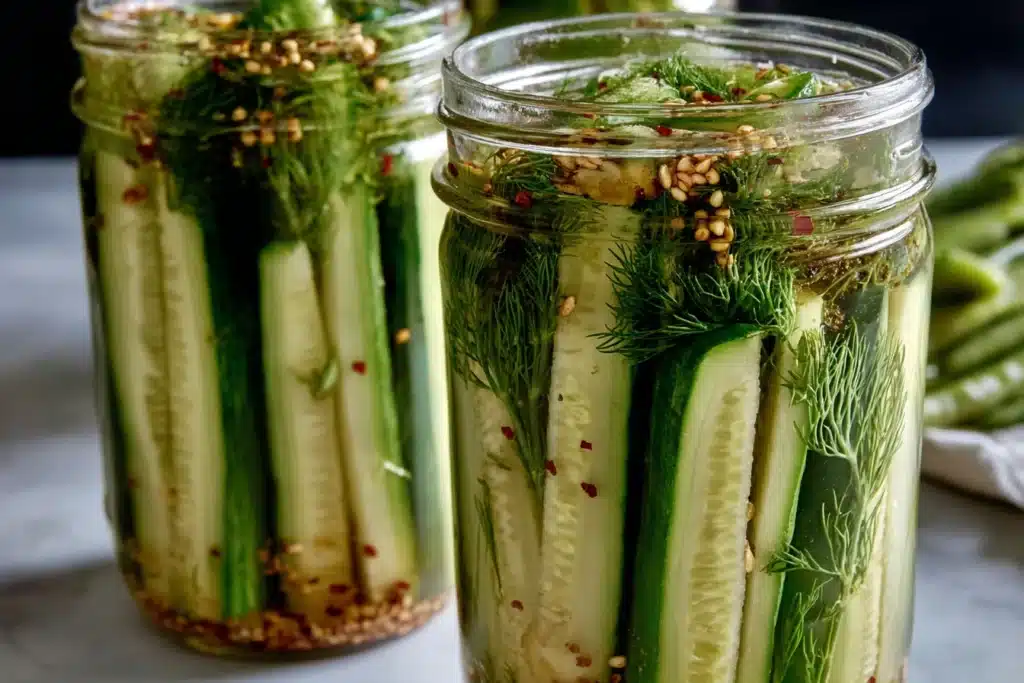
Tips & Variations
- Add onion slices: For extra flavor and variety
- Use apple cider vinegar: For a fruitier twist
- Like it spicy? Add a slice of fresh jalapeño to each jar
- Whole vs sliced cucumbers: Whole stay crisper longer, slices absorb brine faster
Note
Always cool the brine before pouring it over cucumbers to avoid softening them.
Serving Suggestions
- Stack on burgers or sandwiches
- Pair with grilled sausages or hot dogs
- Serve with cheese and charcuterie
- Add to tuna or potato salad
- Snack straight from the jar—no shame
Nutrition Information
Per 1 spear (approx.):
- Calories: 4
- Carbohydrates: 1g
- Sugar: 0.5g
- Sodium: 280mg
- Fat: 0g
- Protein: 0g
- Fiber: 0.2g
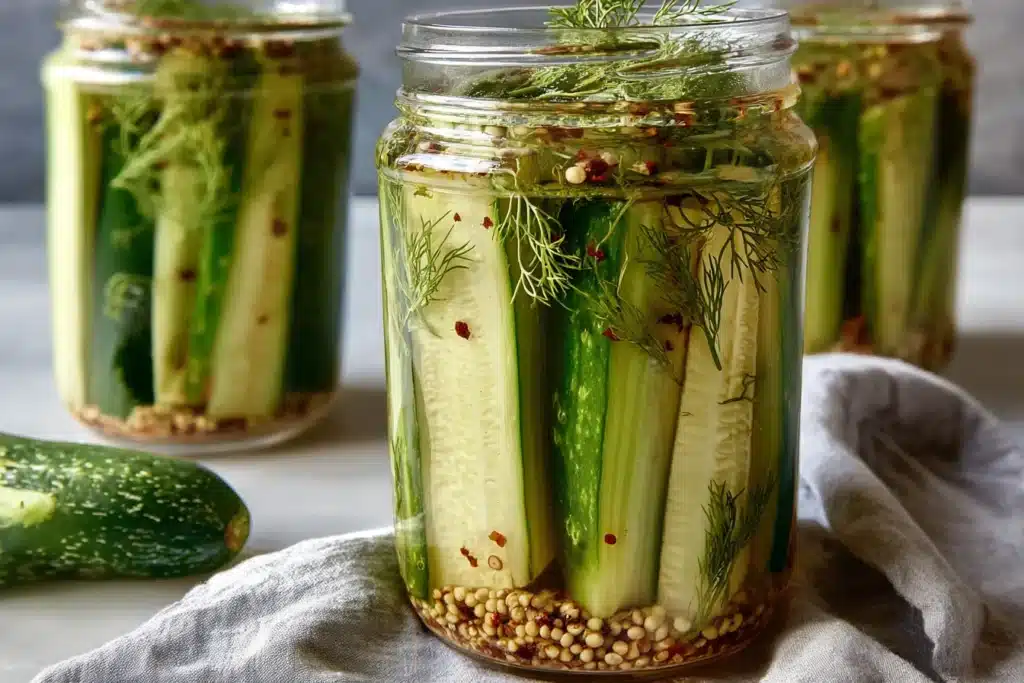
User Reviews/Comments
Carla J. — “These were so easy and had the perfect crunch. I made a second batch the next day.”
Rich E. — “Used garlic and fresh dill from my garden. Amazing results in just two days.”
Amy F. — “This is now my go-to pickle recipe. No more store-bought jars!”
FAQs
How long do these pickles last? Stored in a sealed container in the fridge, they’ll stay crisp and tasty for up to 4 weeks. Just use clean utensils when serving.
Can I use regular cucumbers? You can, but they may soften more quickly. Persian or pickling cucumbers work best due to their size and firmness.
Do I need to sterilize the jars? No need for boiling sterilization—just wash thoroughly with hot, soapy water and rinse well.
Can I reuse the brine? It’s best not to reuse brine for safety and flavor consistency. Make a fresh batch for each new round.
Can I add other vegetables? Absolutely. Try carrots, cauliflower, or even green beans for variety. Just adjust slice sizes for even pickling.
Conclusion
Quick & easy refrigerator dill pickles are a triumph of simplicity and speed. With just a few ingredients and a little fridge time, you get something bold, crunchy, and outrageously addictive. No sterilizing. No fuss. Just clean, honest flavor. These pickles prove that fast doesn’t have to mean flavorless.
If you’re curious about how pickling came to be such a beloved preservation method, dive into the history and science of it on the Pickling Wikipedia page. Then grab some cucumbers and start your own crunchy legacy. Trust me—your sandwiches will thank you.
Print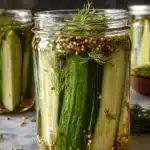
Quick & Easy Refrigerator Dill Pickles Recipe
Ingredients
- 1 lb pickling cucumbers (about 4–6 small)
- 1 cup water
- 1 cup white vinegar (5% acidity)
- 1 tablespoon kosher salt
- 1 teaspoon sugar
- 3 cloves garlic, smashed
- 4 sprigs fresh dill (or 1 tsp dried dill seeds)
- 1/2 teaspoon black peppercorns
- 1/4 teaspoon red pepper flakes (optional)
Instructions
- Prep the Cucumbers: Wash and slice cucumbers into spears or rounds. Set aside.
- Make the Brine: In a saucepan, combine water, vinegar, salt, and sugar. Heat just until salt and sugar dissolve. Let cool.
- Pack the Jar: In a clean mason jar, layer in garlic, dill, peppercorns, and red pepper flakes. Add cucumber slices.
- Pour the Brine: Pour cooled brine over cucumbers until fully submerged. Leave 1/2 inch of headspace.
- Seal and Store: Screw on lid and refrigerate. Let sit 24 hours before eating. Best after 2–3 days.
Notes
Always cool the brine before pouring it over cucumbers to avoid softening them.
